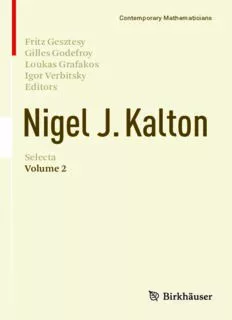
Nigel J. Kalton Selecta: Volume 2 PDF
Preview Nigel J. Kalton Selecta: Volume 2
Contemporary Mathematicians Fritz Gesztesy Gilles Godefroy Loukas Grafakos Igor Verbitsky Editors Nigel J. Kalton Selecta Volume 2 Contemporary Mathematicians Joseph P.S. Kung Editor Moreinformationaboutthisseriesathttp://www.springer.com/series/4817 Fritz Gesztesy • Gilles Godefroy (cid:129) Loukas Grafakos (cid:129) Igor Verbitsky Editors Nigel J. Kalton Selecta Volume 2 Editors FritzGesztesy GillesGodefroy DepartmentofMathematics UniversitéPierreetMarieCurie UniversityofMissouri InstitutdeMathématiquesdeJussieu Columbia,Missouri,USA Paris,France LoukasGrafakos IgorVerbitsky DepartmentofMathematics DepartmentofMathematics UniversityofMissouri UniversityofMissouri Columbia,Missouri,USA Columbia,Missouri,USA ContemporaryMathematicians ISBN978-3-319-18798-3 ISBN978-3-319-18799-0 (eBook) DOI10.1007/978-3-319-18799-0 LibraryofCongressControlNumber:2016940248 MathematicsSubjectClassification(2010):00B60,01A75 ©SpringerInternationalPublishingSwitzerland2016 Thisworkissubjecttocopyright.AllrightsarereservedbythePublisher,whetherthewhole orpart ofthematerial isconcerned, specifically the rights oftranslation, reprinting, reuse of illustrations,recitation,broadcasting,reproductiononmicrofilmsorinanyotherphysicalway, andtransmissionorinformationstorageandretrieval,electronicadaptation,computersoftware, orbysimilarordissimilarmethodologynowknownorhereafterdeveloped. Theuseofgeneraldescriptivenames,registerednames,trademarks,servicemarks,etc.inthis publication does not imply, even in the absence of a specific statement, that such names are exemptfromtherelevantprotectivelawsandregulationsandthereforefreeforgeneraluse. Thepublisher,theauthorsandtheeditorsaresafetoassumethattheadviceandinformationin thisbookarebelievedtobetrueandaccurateatthedateofpublication. Neitherthepublisher northeauthorsortheeditorsgiveawarranty,expressorimplied,withrespecttothematerial containedhereinorforanyerrorsoromissionsthatmayhavebeenmade. Printedonacid-freepaper ThisbookispublishedunderthetradenameBirkhäuser. TheregisteredcompanyisSpringerInternationalPublishingAGSwitzerland(www.birkhauser- science.com) Preface NigelKalton’sresearchspansmorethan40years,andhispublicationsrepre- sentthousandsofpagesoforiginal,deep,andconciselywrittenmathematics. Sadly, the Great Book of Analysis composed by Nigel suddenly closed on August 31, 2010, and we are left with the daunting task of continuing its legacy. But Nigel’s desire clearly was that, no matter the circumstances, research must go on. These selected publications and their commentaries representamodestattempttofulfillthesegoals. EverysinglearticlethatNigelauthored(orco-authored)containsatleast one important result, and a fair number of his contributions completely renewed an entire topic. Therefore, it was quite difficult to select the most significantarticlesinhis formidablebibliography.Thepresentvolumesaim toprovidethemathematicalcommunitywithsomeofNigel’smostinfluential works.Theyincludemostofthemanyfieldstowhichhecontributed. All mathematicians who were privileged to be Nigel’s collaborators, colleagues,orstudentsknowwhataprolificproblemsolverhewas.However, it would not do justice to reduce Nigel’s scientific contributionsto the very impressive list of open problems that he solved. Indeed, Nigel’s vision of mathematics was so far-reaching that it enabled him to use quite exotic objects, such as nonlocally convex spaces, to provide original results in classical and mainstream analysis. Above all, he was a creative mind who wouldsetupthemathematicalframeworkinwhichaquestionisbestputinto itspropercontext,whowouldthenpenetrateitfromallpossibleangles,and whowouldfinallysolveit,alongwithafamilyofrelatedproblems.Therefore, his commanding point of view prepared the ground for future work, and providedhisfollowerswithpreciousnewtools. This volume is a user’s guide to the tools, techniques, and ideas Nigel Kaltongaveus.Indeed,leadingexpertskindlyprovidedinsightfulcomments on each article in our selection. We are mostgratefulto all the contributors to this volume, as they were instrumental in actually realizing the idea of Kalton Selecta. Thanks to their work and expertise, this volume is much more than a mere commemoration of Nigel’s achievements, or a tribute to his memory. We should rather understand it as the proceedings of a major scientific event: an attempt to facilitate the understanding of Nigel Kalton’s contribution,and a starting point for further research on the v vi Preface problems left open. The influence of Nigel’s work is now stronger than ever, and it is our hope that experienced researchers as well as beginners will benefitfromeasyaccess to someof hisfundamentalarticlesandideas. We invite the reader to delve into Nigel Kalton’s work, appreciate every lineofitandallthatcanbefoundbetweenthelines.Whenenteringthisgold mine, one mustbe preparedto dig deep, but in return,greatenjoymentand rewardsshouldbeexpected. We now proceed to a short description of the contents of the Kalton Selecta. We decided not to include in these volumes papers co-authored withourselvesorwithNigel’sdepartmentalcolleagues.Ourintentionwasto pickarticlesfromthevariousfieldstowhichNigelKaltoncontributed.Each articleisprecededbyacontributionwrittenbyanexpert,whoisoften,butnot always,Nigel’scollaborator.Insomecases,thecontributordecidedtogather commentsonseveralrelatedarticlesinasingletext.Fortheconvenienceof thereader,thecommentsandthearticleshavebeenclassifiedintoeightparts: Nonlocally Convex Spaces and Submeasures, DifferentialGames, Operator Theory,HarmonicAnalysisandPDEs,ApproximationTheory,Geometryand Banach Spaces, Interpolation Theory, and Probability and Banach Spaces. Itshould,however,bestressed thatthisclassificationis somewhatarbitrary. Tightlinksexistbetweenthesevariousfields, andthese linksarefrequently duetoNigelKaltonhimself.Indeed,Nigelhadanoutstandingabilitytouse ideasandtechniquesinplaceswheretheywerenotexpectedtobeeffective, and to relate conceptsthat appeareddisjoint to less penetrating minds. Due to the great size of the work that we have collected, it was necessary to split the chapters into two volumes. Nigel’s CV along with the first four parts comprise the first volume, whereas the second volume consists of the remainingfourparts. ThefirstchaptercontainsNigel’sCV,lastupdatedinFebruary2015.PartI covers a field in which Nigel Kalton is the undisputed leader: Nonlocally Convex Spaces. This part contains some deep results about the structure of quasi-Banach spaces, the existence of peculiar objects such as minimal quasi-Banachspaces,andsubmeasures.ThisvoyagethroughtheKaltonzone 0 (cid:2) p < 1 is commentedon by FernandoAlbiac, José LuisAnsorena, Per Enflo,DavidFremlin,AnnaKaminska,andBernardMaurey. PartIIisdevotedtoOptimalControlTheoryanditsrelationshipwithvon Neumann’sGameTheorythroughDifferentialGames.Thecontributortothis partisNigel’sco-authorRobertElliott.PartIIIpresentssomecontributionsto Operatortheory:maximalregularity,Hilbertiantheoryandtraces,similarity problems,andtherecentandcrucialnotionofR-boundedness.Contributions weremadebyFritzGesztesy,TamaraKucherenko,GillesLancien,Vladimir Peller,PierrePortal,andFedorSukochev. Part IV gathers some articles from Harmonic Analysis and Partial Dif- ferential Equations and covers various topics, such as lacunarity in har- monic analysis and H1-functional calculus with its applications to par- Preface vii tial differential equations. Comments for this part are written by Sergei Ivanov, Nikolai Nikolski, Igor Verbitsky, and Lutz Weis. The original arti- cle “The H1-functional calculus and square function estimates” by N. Kalton and L. Weis is published as the seventh chapter of this part. This article has been extensively quoted in the literature and we are grate- ful to Lutz Weis for his decision to publish this article in the Selecta. TheothersetofPartsI–IViscontainedinthesecondvolume.PartI(vol- ume2)concernsApproximationTheory,inthesenseofappliedmathematics, namelyapproximationbysmoothfunctionsorbyvectorswithfinitesupport withagivenrateofconvergence.ContributorstothissectionareYuriBrud- nyi,StephenDilworth,andDenkaKutzarova.PartII (volume2)focuseson theGeometryofBanachSpaces,atopictowhichNigelcontributedinevery possibleway:isomorphictheory,isometrictheory,nonlineargeometry... and ofcourseinterpolationtheory,buttherelevantarticleshaveasectionoftheir own.ContributorstoPartII(volume2)areYoavBenyamini,JesúsCastillo, Garth Dales, Anna Kaminska, Gilles Lancien, Mikhail Ostrovskii, Gilles Pisier,andDirkWerner. Part III (volume 2) is relevant to interpolation theory and the fasci- nating links between interpolation lines, twisted sums, quasi-linear maps, weakerdistancesbetweennon-isomorphicBanachspacesandthenonlocally convex world. Nigel’s contribution to this field is such that it is fair to designate the corresponding theory as the Kalton calculus. Contributors to this section are Michael Cwikel, Mario Milman, Richard Rochberg, and Stephen Dilworth. Finally, Part IV (volume 2) is devoted to certain aspects oftheinterplaybetweenProbabilityTheoryandBanachSpaces:decoupling property,spaces generated by a sequence of independentrandom variables, andRademacherseries.ContributorstothissectionareStephenDilworthand StephenMontgomery-Smith. We conclude this introduction by expressing our deepest gratitude to all thecontributorstothisvolume.Theircommentsprovidethebesttributethey could pay to Nigel’s memory:a mathematical analysis of his works. More- over,wethankthem,andnumerouscolleaguesandfriends,mathematicians, andpublishers,fortheirencouragement,generousadvice,hands-onhelp,and steadfastsupportinthepreparationoftheseKaltonSelecta.Inparticular,we sincerely thank each of the publishers involved for granting us permission to include their pdf files in these volumes. We are particularly indebted to Michael Cwikel not only for spearheading the extensive commentaries on interpolation theory in Part III, but also for supplying us with numerous comments and correctionsthroughoutthe Selecta. His level of involvement withthisprojectwentfarbeyondanythingwecouldhavepossiblyexpected. ManythanksareduetoBirkhäuserSpringerVerlagandtheextraordinary supportofferedbyThomasHempfling,AnnaMaetzener,KarinNeidhart,and ChristianeTretter.We alsoexpressourspecialgratitudetoJennyKaltonfor allherhelpandsupportthroughouttheentireproject. viii Preface Finally,wededicatethisbooktoNigelKalton.ThankyouNigel,foralife devotedtomathematics. Columbia,Missouri,USA FritzGesztesy Paris,France GillesGodefroy Columbia,Missouri,USA LoukasGrafakos Columbia,Missouri,USA IgorVerbitsky Contents PartI ApproximationTheory Polynomial approximation on convex subsets of Rn byY.A.BrudnyiandN.J.Kalton.............................. 3 Y.A. Brudnyi: Comments on the Paper “Polynomial approximationonconvexsubsetsofRn”byY.A.Brudnyiand N.J.Kalton,Constr.Approx.16(2000),161–199................. 43 Thethresholdinggreedyalgorithm,greedybases,anddualityby S.J.Dilworth,N.J.Kalton,D.Kutzarova,andV.N.Temlyakov.... 49 S.J. Dilworth: Comments on the Paper “The thresholding greedyalgorithm,greedybases,andduality”byS.J.Dilworth, N.J.Kalton,D.Kutzarova,andV.N.Temlyakov,Constr.Approx. 19(2003),575–597........................................... 73 ConvergenceoftheweakdualgreedyalgorithminL -spacesby p M.GanichevandN.J.Kalton................................. 79 S.J. Dilworth: Comments on the Paper “Convergence oftheweakdualgreedyalgorithminL -spaces”byM.Ganichev p andN.J.Kalton,J.Approx.Theory124(2003),89–95............ 87 Onthe existenceof almostgreedybases inBanachspacesby S.J.Dilworth,N.J.KaltonandD.Kutzarova.................... 93 D.Kutzarova:CommentsonthePaper“Ontheexistenceofalmost greedybasesinBanachspaces”byS.J.Dilworth,N.J.Kaltonand D.Kutzarova,StudiaMath.159(1)(2003),67–101.............. 129 PartII GeometryofBanachSpaces TheuniformstructureofBanachspacesbyN.J.Kalton.......... 135 Y.Benyamini:CommentsonthePaper“Theuniformstructure of Banach spaces” by N.J. Kalton, Math. Ann. 354 (2012), 1247–1288.................................................. 178 ix
Description: